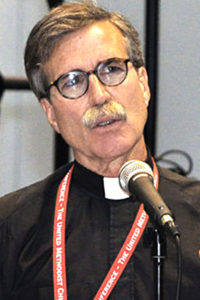A Joyful Pilgrimage
The Church recognizes the absolute necessity of repetition. The Christian Year repeats its seasons—Advent through Pentecost Season (or Ordinary Time)—year after year, so that the
congregation and the individual can be renewed in the whole Gospel. Week after week, the Church’s liturgy repeats familiar readings from the Word, and gives bread and wine and water. The Church’s creeds, Apostles’ and Nicene, repeat the sweep of salvation history for a congregation at worship.
Why all this repetition? The Church realizes that the truths of the Gospel can be lost—by forgetfulness or by compromise—if they are not regularly and faithfully repeated by the People of God. The demands of everyday life, the power of digital media, the seductions of the evil one, and the proneness to wander can distract the local church and the Christian from Jesus Christ. In response to this dangerous reality, the Church faithfully repeats the truths she has received. And repeats. And repeats—until Christ returns in glory.
An annual pilgrimage is another example of the Church’s tendency to repeat. Such a pilgrimage renews its pilgrims in Gospel truths that are essential to their lives. For example, the annual March for Life can be understood as a pilgrimage that renews its participants in the Gospel truth that God creates every person in the divine image, so every person is to be loved and protected.
* * *
On January 22, 1974, the first anniversary of Roe v. Wade, a Washington DC lawyer named Nellie Gray launched the March for Life on the steps of the Supreme Court to build resistance to the abortion-on-demand regime the Court had declared the year before. While Roe was overturned this past June, the March will continue until the right to life is restored to unborn children—until abortion is made “unthinkable.”
Here’s what the March looks like: Tens of thousands of prolifers descend upon the nation’s capital. Buses seem to be their standard mode of travel. At noon on the day of the march, they assemble for a rally on the National Mall near the Washington Monument, listening to a variety of speakers gathered on a gigantic, raised stage. Politicians and actors, bishops and pastors and rabbis, former abortionists and abortion survivors, representatives of the disabled, and many others take their turn delivering strong speeches about God’s gift of human life. After around ninety minutes, this mass of humanity moves to nearby Constitution Avenue and then marches up Capitol Hill. Once on the Hill, marchers proceed to the steps of the Supreme Court, where more speeches are delivered, and/or visit the offices of their US representatives or senators. By mid-to-late afternoon, most marchers are beginning their trip home—whether it cover 30 or 3,000 miles.
This year’s March took place on January 20, a Friday. There had been some concern that the fall of Roe would mean that fewer participants would attend. Exact counts are unavailable, but one source estimated there were 100,000 people in attendance this year. The weather was cold but clear. As usual, the crowd was overwhelmingly young and energetic. Tens of thousands of high school and college students from across the United States participated. They themselves were full of life—hopeful, friendly, fun-loving, and surprisingly thoughtful. And they witnessed for life—by listening to speeches, applauding memorable lines, joining in chants, carrying signs, and marching up the Hill.
Most who have not attended a March for Life would probably imagine it as a grim, depressing affair. To be sure, there are shocking reminders of what the March opposes. The large pictures of butchered babies mounted on mobile units cannot be avoided. But joy sets the tone. The thousands of youthful marchers—sometimes silent and attentive, sometimes loud and laughing— tend to pull even the sullen out of their negativity. Just by being there, the young witness so clearly to God’s gift of life, to the Gospel of Life.
Major culture-forming institutions in American society—BigTech, Big Media, Big Business, Hollywood, popular entertainment, higher education, oldline religious denominations, and the Democratic Party—generally support the right to abortion. Only the Roman Catholic Church, the United States Supreme Court (for now), and We the People reject the notion of an absolute abortion liberty in America.
Participating in the March for Life is like making an annual pilgrimage, one that is desperately needed. After all, recognized or not, the “abortion-is-good” messaging comes at all of us
all the time. Becoming a pilgrim for life, one is renewed in the truth that every human being, including the youngest and smallest, is God’s gift. Therefore, it is not only our duty but our privilege to protect and defend these little ones.
Next year, participate in the March as a pilgrim. Do the same the next year, and the year after that. We need—no, require—the renewal these pilgrimages bring.
________________________________
Original Bio:
—Rev. Paul Stallsworth is a United Methodist minister. Retired from pastoral ministry, he edits the quarterly newsletter Lifewatch, which is published by the Taskforce of United Methodists on Abortion and Sexuality. With his wife Marsha, he lives in Wilson, NC.
(updated June 2023)



